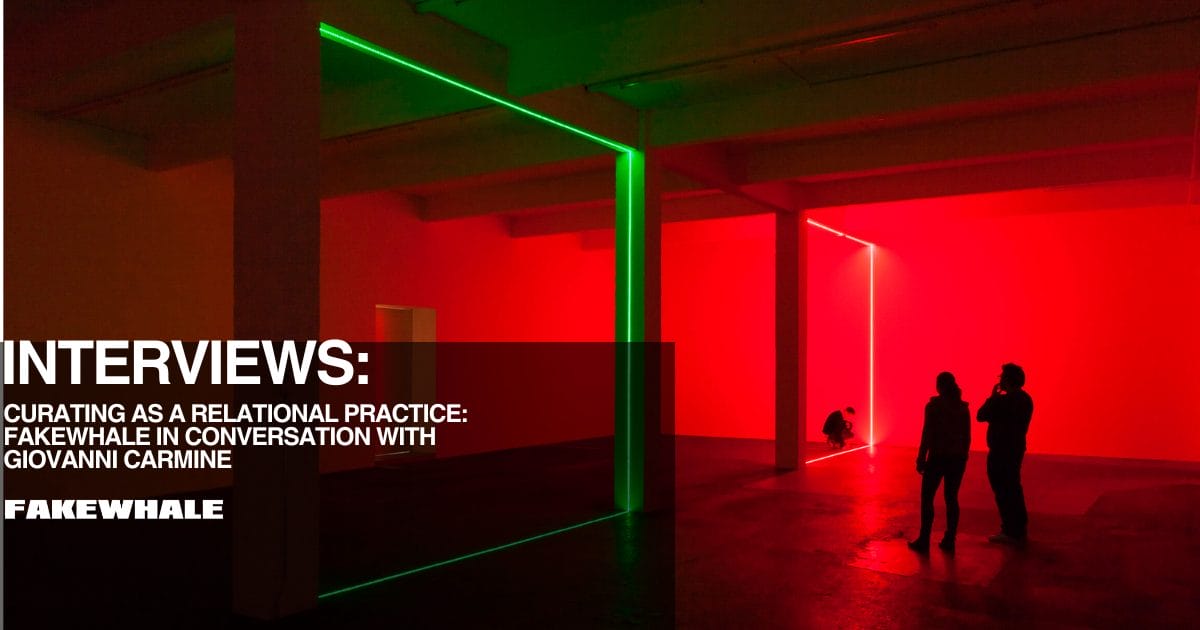In the landscape of contemporary art, the role of the curator has undergone a profound transformation in recent decades, becoming increasingly hybrid, complex, and influential. Giovanni Carmine is a key figure in this evolution: from his early beginnings in the Swiss independent scene to his directorship at the Kunst Halle Sankt Gallen, and most recently as the curator of Unlimited at Art Basel, his trajectory reflects a constant dialogue between artistic research, curatorial precision, and an openness to emerging practices. In this interview, we retrace the key moments of his career, explore the changing dynamics of the contemporary art system, and ask how the role of the curator is being redefined today, between institutions, artists, and audiences.

Giovanni Carmine, Portrait
Fakewhale: Good morning Giovanni, thank you for accepting our invitation. We’d like to begin this interview by asking you how you first got involved in curating. What was your first concrete experience in organizing an exhibition?
Giovanni Carmine: My first experience dates back to 1998, when I curated a show dedicated to graffiti.
At the time, I was still at university, and together with some friends and colleagues, we had started taking an interest in the graffiti phenomenon, partly because there was a complete lack of critical or academic literature on the subject.
A small contemporary art center in my hometown reached out unexpectedly, asking me to organize an exhibition on that very topic, probably because another planned show had fallen through.
Although I had no direct experience, I felt a deep interest in the idea of curating exhibitions, so I accepted. That was my first show…

Exhibition view, «Land of Crystal», Mai-Thu Perret, Kunst Halle Sankt Gallen, St. Gallen, CH, 2008. Kunst Halle Sankt Gallen.
Let’s now turn to your transition into the role of director of Unlimited at Art Basel. How did this new phase reshape your curatorial approach?
Those were years of significant professional growth.
This year marked the end of my fifth and final edition as curator of the Unlimited section at Art Basel.
In the meantime, I gained a wide range of experience, including on an international level.
Among the most important projects was my collaboration as co-curator with Bice Curiger for the Venice Biennale in 2011.
I began working on large-scale exhibitions, and I believe that the credibility I had built over the years, among artists, galleries, and institutions, helped make my involvement with Art Basel feel like a natural progression.

Exhibition view, «Dumm schauen und Kekse fressen», Beni Bischof, Kunst Halle Sankt Gallen, St. Gallen, CH, 2010. Courtesy Kunst Halle Sankt Gallen.
Looking back on your journey, were there any figures, artists, curators, or others, who particularly influenced you, either conceptually or in terms of your working methods?
At the beginning of my career, a few figures from the Zurich art scene had a fundamental impact on me.
I’m thinking in particular of Rein Wolfs, who was then curator at the Migros Museum.
What struck me was his inclusive, informal, almost familial, approach to engaging with the public, and the way he built a real cultural scene around the museum.
Another important figure for me has been Bice Curiger, whose work I’ve followed closely over the years.
And of course, among the major influences, there’s Harald Szeemann: a legendary figure whom I was fortunate enough to meet and whose work I was able to study up close. (…)”
READ THE FULL INTERVIEW ↓
USEFUL LINKS:



